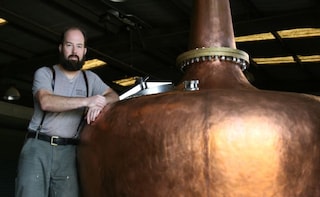Call them American originals, flattering imitators or spunky, funky derivatives. Call them smart business choices or unique expressions of region and craft; call them intensely smoky, delicately aromatic, honeyed and heavenly.
What distillers should and shouldn't do in the process of making a particular spirit is always a matter of debate. Centuries of tradition and Scottish regulations govern what a Scottish single malt can be, but here in the States, single malts don't yet have their own legal standard of identity. Many distillers would like to see that change, and they have formed the American Single Malt Whiskey Commission to advance standards they say any American spirit calling itself a single malt should meet.
Lance Winters, master distiller at St. George's, says it's too early for that. American single malt is still in its infancy, he notes, and more regulation might stifle the creativity that would help the category grow. Instead of petitioning for definitions, he says, he'd like the industry to fight for more transparency, so a bottle's labeling always makes it clear to consumers exactly what they're buying in terms of age, contents, etc.Right now, Risen says, our single malt style "is that there is no style. That's kind of the American brand: Anything goes."
(This story has not been edited by NDTV staff and is auto-generated from a syndicated feed.)
Advertisement
Advertisement
Advertisement
Advertisement
What distillers should and shouldn't do in the process of making a particular spirit is always a matter of debate. Centuries of tradition and Scottish regulations govern what a Scottish single malt can be, but here in the States, single malts don't yet have their own legal standard of identity. Many distillers would like to see that change, and they have formed the American Single Malt Whiskey Commission to advance standards they say any American spirit calling itself a single malt should meet.
Lance Winters, master distiller at St. George's, says it's too early for that. American single malt is still in its infancy, he notes, and more regulation might stifle the creativity that would help the category grow. Instead of petitioning for definitions, he says, he'd like the industry to fight for more transparency, so a bottle's labeling always makes it clear to consumers exactly what they're buying in terms of age, contents, etc.Right now, Risen says, our single malt style "is that there is no style. That's kind of the American brand: Anything goes."
(This story has not been edited by NDTV staff and is auto-generated from a syndicated feed.)
For the latest food news, health tips and recipes, like us on Facebook or follow us on Twitter and YouTube.
Advertisement
